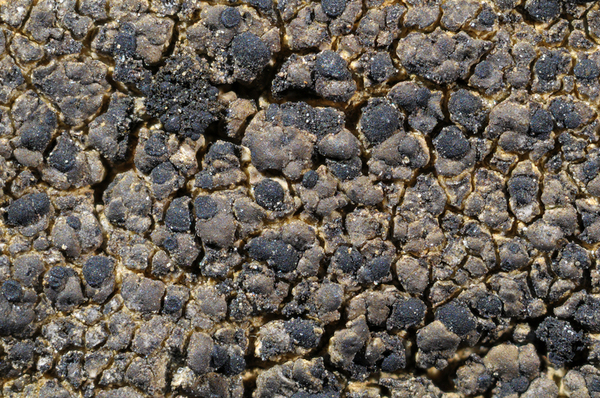Kiliasia pennina (Schaer.) Kistenich, Timdal, Bendiksby & S. Ekman
Taxon, 67: 892, 2018.. Basionym: Lecidea pennina Schaer. - Lich. Helv. Spicil., 3: 120, 1828.
Synonyms: Biatora pennina (Schaer.) Hepp; Catillaria scotina (Körb.) Hertel & H. Kilias; Lecidea aeneiformis (Anzi) Jatta; Lecidea scotina (Körb.) Arnold; Lecidella scotina Körb.; Psora aeneiformis Anzi; Toninia pennina (Schaer.) Gyeln.
Description: Thallus crustose to subsquamulose, episubstratic, medium to dark brown, epruinose to weakly pruinose, consisting of up to 1(-1.5) mm wide, scattered to contiguous, orbicular to angular, flat or weakly convex areoles/squamules. Cortex 40-70 µm thick, overlain by an up to 30 µm thick epinecral later, lacking crystals; medulla white, without crystals. Apothecia lecideine, black, epruinose or faintly pruinose, 0.2-0.8 mm across, with a flat to convex disc and a thin, finally often excluded proper margin. Proper exciple grey in outer part, pale grey to colourless within, the pigmented parts K+ and N+ violet, without crystals; epithecium grey, K+ and N+ violet, 9-20 µm high; hymenium colourless, 50-60 µm high; paraphyses easily made free, 1.8-2.6 µm thick at mid-level, the apical cells clavate, up to 8 µm wide, surrounded by a pigmented gel; hypothecium colourless, without crystals, 60-150 µm high. Asci 8-spored, cylindrical-clavate, surrounded by a gelatinous I+ blue coat, with a well-developed I+ blue tholus with a I+ darker blue tube and a well-developed ocular chamber, Bacidia-type. Ascospores 1-3-septate, hyaline, bacilliform or partly fusiform, 8.5-13(-16) x 3-5 µm. Pycnidia black, immersed. Conidia thread-like. Photobiont chlorococcoid. Spot tests: thallus K+ violet (cortex, in section!), C-, KC-, P-, UV-. Chemistry: cortex, exciple and epithecium with the Sedifolia-grey pigment.
Growth form: Crustose
Substrata: rocks
Photobiont: green algae other than Trentepohlia
Reproductive strategy: mainly sexual
On otherwise dry surfaces with short periods of water seepage after rain
Commonnes-rarity: (info)
Alpine belt: absent
Subalpine belt: rare
Montane belt: very rare
Dry submediterranean belt: absent
Humid submediterranean belt: absent
Padanian area: absent
pH of the substrata:
1 2 3 4 5
Solar irradiation:
1 2 3 4 5
Aridity:
1 2 3 4 5
Eutrophication:
1 2 3 4 5
Poleotolerance:
0 1 2 3
Altitudinal distribution:
1 2 3 4 5 6
Rarity
absent
extremely rare
very rare
rare
rather rare
rather common
common
very common
extremely common
Loading data...
Occurrence data
Predictive map
Growth form: Crustose
Substrata: rocks
Photobiont: green algae other than Trentepohlia
Reproductive strategy: mainly sexual
On otherwise dry surfaces with short periods of water seepage after rain
Commonnes-rarity: (info)
Alpine belt: absent
Subalpine belt: rare
Montane belt: very rare
Dry submediterranean belt: absent
Humid submediterranean belt: absent
Padanian area: absent
pH of the substrata:
| 1 | 2 | 3 | 4 | 5 |
Solar irradiation:
| 1 | 2 | 3 | 4 | 5 |
Aridity:
| 1 | 2 | 3 | 4 | 5 |
Eutrophication:
| 1 | 2 | 3 | 4 | 5 |
Poleotolerance:
| 0 | 1 | 2 | 3 |
Altitudinal distribution:
| 1 | 2 | 3 | 4 | 5 | 6 |
Rarity
absent
extremely rare
very rare
rare
rather rare
rather common
common
very common
extremely common
Loading data...
Occurrence data
Predictive map







